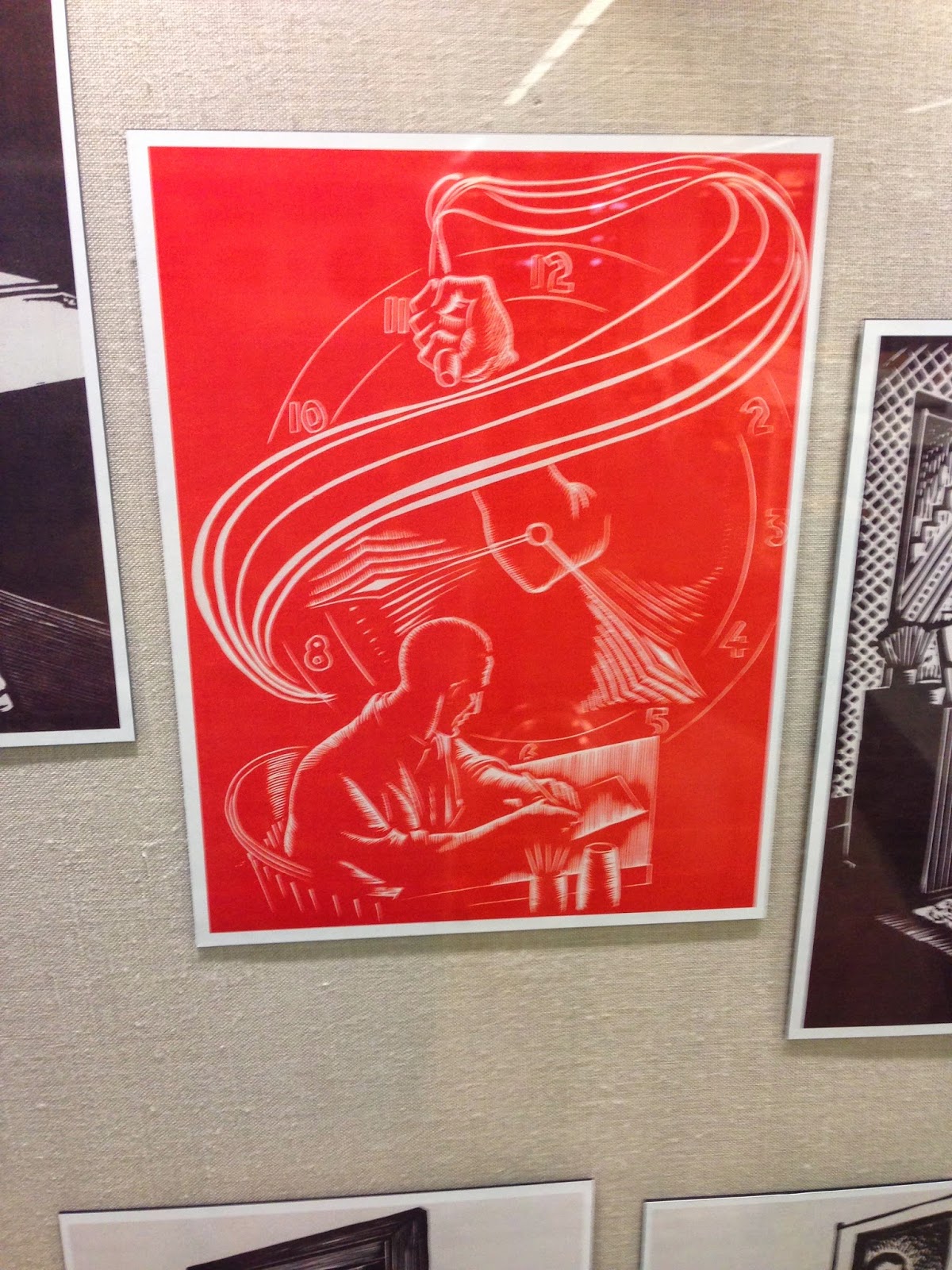The Labor Archive and Research Center at the SFSU J. Paul Leonard Library has a display of the long out of print 1940 book White Collar: A Novel in Linocuts by Giacomo Patri (1898–1978), which is illustrated with linocut prints in two colors. The first edition of this wordless volume was hand printed by Patri and bound with his wife's assistance, two other editions were commercially printed.
Patri was born in Italy. Frustrated with a series of unfulfilling jobs, he went to night school to learn to be an artist. He worked in different capacities for 3 bay area newspapers, The San Francisco Examiner, The Call-Bulletin, and The San Francisco Chronicle. In the WWII era, he began teaching at the California Labor School and became the head of the Art Dept, while also doing freelance work for unions. After the Labor School was closed during the Red Scare in 1957, he had his own art school and kept freelancing until he retired in 1966.
The story follows the life of a mid-level advertising executive who suffers joblessness and tragedy after the 1929 stock market crash. Patri saw that white collar workers considered themselves professionals who saw no benefit from the union protections earned by blue collar workers, so they frequently shunned organizing campaigns and union activity. In the book Patri contrasts the isolation of the white collar worker trying to solve his own problems in isolation with the activity of the collective, eventually resulting in the white collar worker joining in united action. Here is a blog post with very clear scans.
The photos below are cell snaps of the exhibit in 4 cases on the 4th floor of the library.
Monday, July 21, 2014
Sunday, July 20, 2014
On Reflection: the Art of Margaret Harrison
 |
| Margaret Harrison. The Last Gaze. 2013 Northern Art Prize winner. |
Based on the Pre-Raphaelite painting of the Lady of Shalott by Waterhouse and the ballad by Alfred Lord Tennyson, Harrison uses the myth of "the Lady" to comment on contemporary issues.
 |
| Margaret Harrison. The Last Gaze (detail). 2013 |
 |
| Mirror reflecting The Last Gaze. |
In 2015 & 2016, Harrison will be showing this piece and other new work in shows at the Golden Thread Gallery in Belfast, the Middlesbrough Institute of Art (UK), and the Ronald Feldman Gallery in New York, as well as touring exhibits of older work through the Tate, and other gallery shows in Berlin and London.
Margaret and I have been collaborating on a book that would include biographical information and an overview of her work and career entitled On Reflection: the Art of Margaret Harrison. If you would like to see more images or and a proposal, please contact me at kim_munson AT yahoo.com.
Dual Views: Labor Landmarks show to open April 2015
 |
| Landmarks photography by Wendy Crittenden (color, top) and Tom Griscom (B&W, below)
Dual Views: Labor Landmarks of San Francisco will be exhibited at SFSU from April 2, 2015 through mid-July (details below). Taken in 2008 in the recovery from the 1999-2000 tech boom/bust cycle, Griscom’s black and white panoramas and Crittenden’s askew color c-prints celebrate the resilience of the ever-changing Waterfront, South of Market,Glen Park, Dogpatch, and North Beach areas while searching for echoes of their turbulent history.
The two photographers separately visited sites both iconic and “under the radar,” in an effort to capture the rebuilding period between economic cycles and to draw attention to the underlying history of militant labor struggles that helped shape the physical and political landscape of the city. While sifting through archival materials for this show, I continue to be amazed both by the dramatic changes in the city from one period to the next, and at the sacrifices people made to fight off companies that were exploiting their work. The Dual Views show will be exhibited in the Special Collections Gallery on the 4th floor of the newly remodeled J. Paul Leonard Library at San Francisco State University, opening April 2nd and going through mid-July. An opening event/reception on April 2 and a closing event to coincide with Laborfest are being planned. As alumni, Tom, Wendy and I are all looking forward to finally showing this body of work at SFSU, and have been happy to continue our relationship with the Labor Archives and LARC director Catherine Powell. The show will feature 11 photos each from Crittenden and Griscom, plus contextual material pulled from LARC's deep collection of historical artifacts. I have been developing a catalog, and hope to announce how it can be accessed soon. You can preview some of the pieces that will be featured in the show in the slideshow below. If you are a publisher and are interested in seeing a proposal, please contact me at kim_munson AT yahoo.com and I will be happy to send you one. |
Subscribe to:
Comments (Atom)








